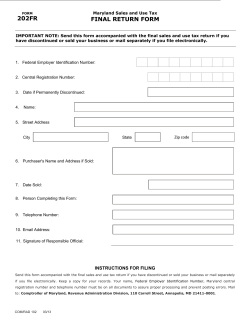
- Parchment Exchange
Receiving Parchment Data Via SPEEDE Lessons Learned and Best Practices About University of Maryland University College UMUC offers the best of both worlds—a convenient online education from a respected state university. • A member of the University System of Maryland, providing credibility and recognition in the job market. • For more than 65 years, UMUC has provided educational opportunities to students around the world, earning the university a global reputation for excellence. • UMUC is the largest public university in the country, educating more than 95,000 students. • With divisions in Asia and Europe and a presence on military installations in more than 25 countries and territories, UMUC is also a leading provider of education services to the U.S military. http://umuc.edu/visitors/about/ 2 About Patrick Elliott • Associate Registrar with 10 years of experience in higher education; • Manages Parchment Receive Premium services for UMUC; • Eight years of experience working with electronic transcripts, electronic data interchange (EDI), optical character recognition (OCR), and document imaging systems; • Active within AACRAO and CAPACRAO (Maryland and DC chapter). patrick.elliott@umuc.edu https://www.linkedin.com/in/pselliott 3 The Problem • UMUC receives about 65,000 transcripts per year; • In 2014 about 13% of transcripts came in pure data format (EDI); • Goal is to receive > 30% EDI by 2018; • UMUC and the University System of Maryland is heavily invested in SPEEDE EDI; • Increased pressure to cut cost and improve efficiency. 4 What is SPEEDE? Source: Bliss, H. (2013, August 5). “Do you know why I pulled over?” New Yorker. Retrieved from hJp://www.condenaststore.com/-‐sp/ Do-‐you-‐know-‐why-‐I-‐pulled-‐you-‐over-‐New-‐Yorker-‐Cartoon-‐ Prints_i9717282_.htm 5 What is SPEEDE? • Developed by AACRAO taskforce and launched in 1995; • Standardized format of data for sending requests for transcripts, transcripts, and transcript acknowledgements; • No fees to use; • Adheres to national standards and can work with other networks using those standards (e.g., Parchment). Source: Tashjian, T. & Stones, D. (2012). The UT SPEEDE Server: The Past, Present, and Future… Sending Electronic Transcripts. PowerPoint presenta]on at the AACRAO Annual Mee]ng, San Francisco, CA. Retrieved from hJp://handouts.aacrao.org/am12/finished/DavidStones81648916.pdf 6 University System of Maryland ET Server • Homegrown system; • Operated by USM information technology staff; • Serves the 11 degree-granting constituents of the system and Maryland community colleges and secondary schools; • Spoke and hub model; • UMUC receives one daily batch. 7 The Solution • Integrate Parchment and SPEEDE; • Have Parchment send any transcript with underlying data through SPEEDE (no PDF, just data); • Identify top receivers that also use Parchment Send and work with Parchment to develop data templates (send more through SPEEDE); • Started process in July 2014 and started receiving data in April 2015. 8 The Reasons Behind the Solution • Budget constraints – needed to use available systems and technology; • Because of spoke and hub model, Parchment could not push EDI via SFTP; • Supporting Maryland’s commitment to SPEEDE. 9 Challenges & Lessons Learned • Integrating with a homegrown system; • First time opening up Maryland ET server to a vendors; • Update SPEEDE registrant data to capture Parchment SPEEDE senders; • Parchment unified inbox, custom destinations, and filters; • Reframing the goal: make it quicker and easier for students to submit credentials by supporting all major electronic transcript networks. 10 Thank you! Any questions? 11
© Copyright 2025









